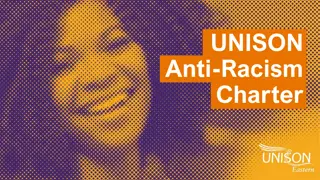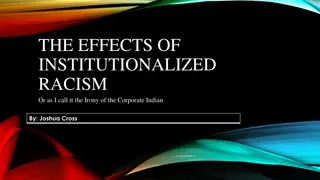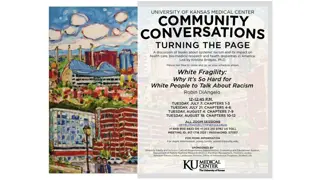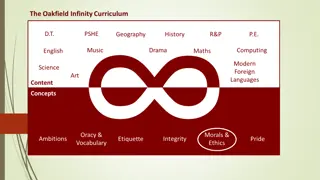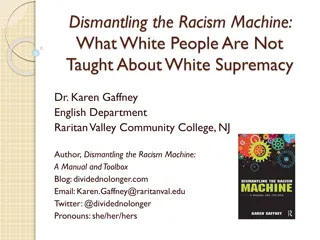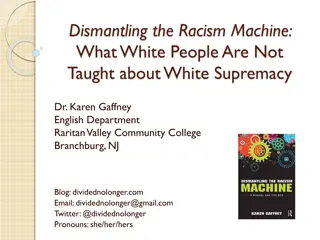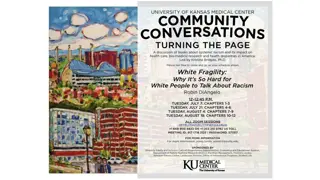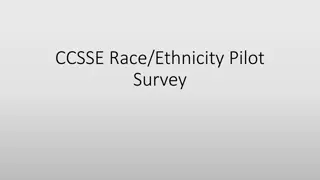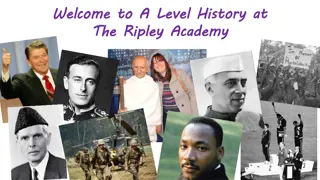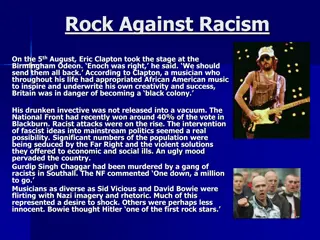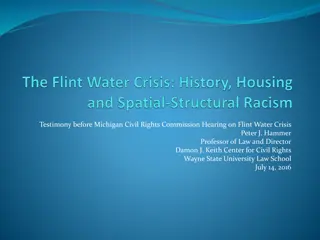Book Club: Understanding History and Racism
Explore the impact of racism and racial disparities through a book club focused on personal growth, provoking emotional responses, and committing to action and systems change. The club delves into definitions, blackness and whiteness, breaking silence, and confronting societal norms. Engage in conversations to raise consciousness and challenge prejudices for a more equitable future.
Download Presentation

Please find below an Image/Link to download the presentation.
The content on the website is provided AS IS for your information and personal use only. It may not be sold, licensed, or shared on other websites without obtaining consent from the author.If you encounter any issues during the download, it is possible that the publisher has removed the file from their server.
You are allowed to download the files provided on this website for personal or commercial use, subject to the condition that they are used lawfully. All files are the property of their respective owners.
The content on the website is provided AS IS for your information and personal use only. It may not be sold, licensed, or shared on other websites without obtaining consent from the author.
E N D
Presentation Transcript
Understand history and systems Practice talking about racism and racial disparities Personal learning and growth to create a shift within individuals Provoke an emotional state (discomfort, empathy, outrage) that raises our consciousness Commit to action and systems change Small Groups/ Peer facilitators Spectrum of learning no endpoint The purpose of this book club
February 9th Part I: A Definition of Terms (Introduction and Chapters 1-2) March 9th Part II: Understanding Blackness in a White Context (Chapters 3-5) April 13th Part III: Understanding Whiteness in a White Context (Chapters 6-7) May 11th Part IV: Beyond Black and White and Breaking the Silence (Chapters 8-10)
Not everything that is faced can be changed. But nothing can be changed until it is faced. James Baldwin
There is someone in every audience who suggests racism is a thing of the past someone who hasn t noticed: Stereotypical images of POC in the media Housing discrimination in their community Documented racial bias in lending practices among well-known banks Accounts of racial tracking patterns in schools Disproportionate incarceration and police killings of POC Racial health disparities in every domain of health, including life expectancy Isn t Racism a thing of the past?
Societal norms and values Who is beautiful Who is powerful Who is smart Who is a criminal Who are our heroes The impact of racism begins Segregated communities Limited information about other racial groups Stereotypes, omissions, and distortions contribute to prejudice Prejudice is a preconceived judgement or opinion usually based on limited information 3 yr olds hold stereotypes that become the foundation of prejudice early. Internalized superiority or inferiority
We all have prejudices Not because we want them, but because we have been continually exposed to misinformation about others We are not to blame for the negative messages we internalized We are responsible for acknowledging and examining prejudice Look at our own behavior Am I perpetuating or challenging prejudices Am I seeking exposure to positive images of marginalized groups Conscious acts of reflection and reeducation Prejudice is not your fault, but it is your responsibility
Racism is not just personal ideology based on racial prejudice Racism is a system of economic, political, social, and cultural structures, actions, and beliefs that perpetuate an unequal distribution of privileges, resources and power between racial groups. Racism: A system of advantage based on race Racism = (racial) prejudice + (social) power Hundreds of years of anti-black/pro-white racial prejudice, born to justify slavery, maintained as a political tool of control through Jim Crow laws, segregation, mass incarceration White supremacy white people in the position to disseminate and protect their self-image, worldview, and interests across the entire society.
What is really being asked is: Are you saying all white people are bad? Answer: Of course not Are you saying all white people are racist? The more relevant question is: What are white people as individuals doing to interrupt racism? Active racism KKK, Archie Bunker Passive racism Laughing racist jokes Letting exclusionary hiring practices go unchallenged Accepting the omissions of POC from the curriculum Avoiding difficult race-related issues/conversations All that is required to maintain racism is to go about business as usual.
"I sometimes visualize the ongoing cycle of racism as a moving walkway at the airport. Active racist behavior is equivalent to walking fast on the conveyor belt Passive racist behavior is equivalent to standing still on the walkway. No overt effort is being made, but the conveyor belt moves the bystanders along to the same destination as those who are actively walking. Some of the bystanders may feel the motion of the conveyor belt, see the active racists ahead of them, and choose to turn around But unless they are walking actively in the opposite direction at a speed faster than the conveyor belt unless they are actively antiracist they will find themselves carried along with the others." Beverly Daniel Tatum
Defining the personal significance and social meaning of belonging to a particular racial group People belonging to the dominant social group (white, male, heterosexual, etc) typically take those identities for granted I am ___________ Racial Identity development
otherness ism Race or ethnicity Racism Gender/gender expression Sexism Religion Religious oppression/anti-Semitism Sexual orientation Heterosexism At least 7 categories of otherness in US society Socioeconomic status Classism Age Ageism Physical or mental ability Ableism In each case, there is a group considered dominant (systematically advantaged by the society because of group membership) and a group considered minoritized or targeted (systematically disadvantaged). Most of us will find that we are both dominant and targeted at the same time. But it is the targeted identities that hold our attention and the dominant identities that often go unexamined.
Oppression happens at all levels Individual feelings, beliefs, values Interpersonal actions, behaviors, language Institutional legal system, education system, policy Societal/Cultural collective ideas about what is right
Policy Socio-ecological model Vote Advocate for change Community Organizational Hiring and retention Voices at the table Examining policies Antiracist Action Interpersonal Stop microaggresions Expand your network Individual Learn the history Challenge assumptions Racial identity development
Honor Confidentiality Small Groups Choose courage over comfort Regard feedback as a generous gesture that should always be met with gratitude
1. What stands out to you from the reading or todays presentation? 2. What are you individually doing to stop systemic racism? What are some actions you can take at each level of the socio- ecological model? 3. What race- related questions do you have that you hope your group will discuss now, or at a future session? Discussion Questions 4. Which aspects of your identity have you been actively exploring? Which parts of your identity are relatively unexamined? 5. How much do you know about people with identities different from yours and how did you learn it?


